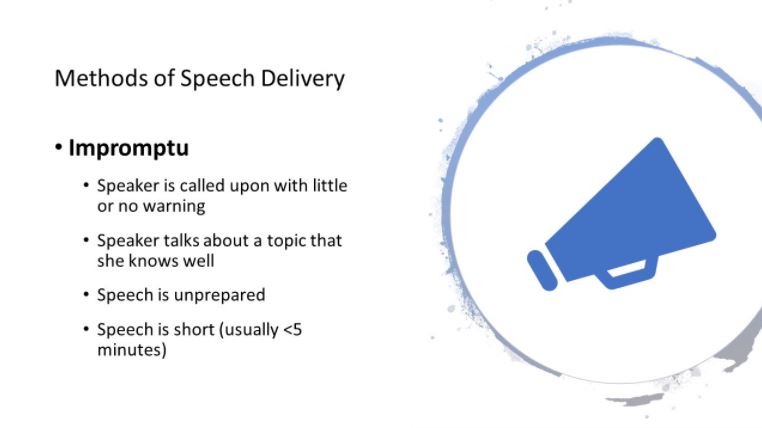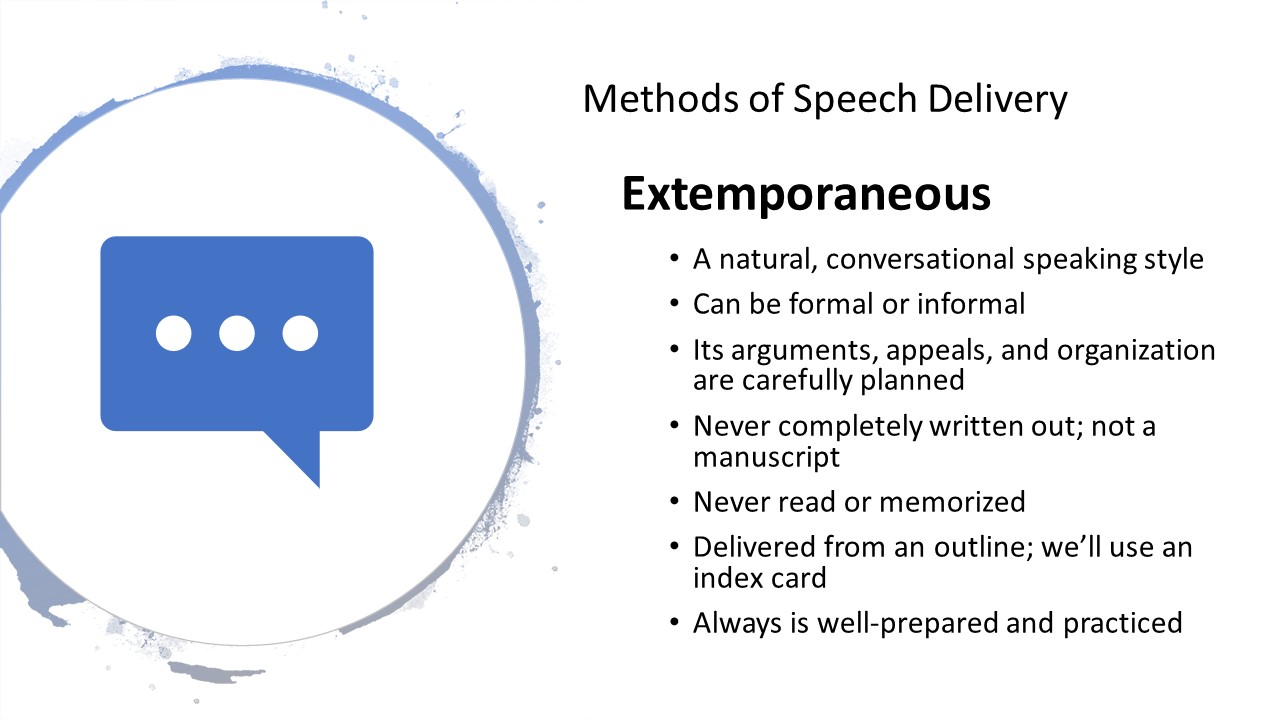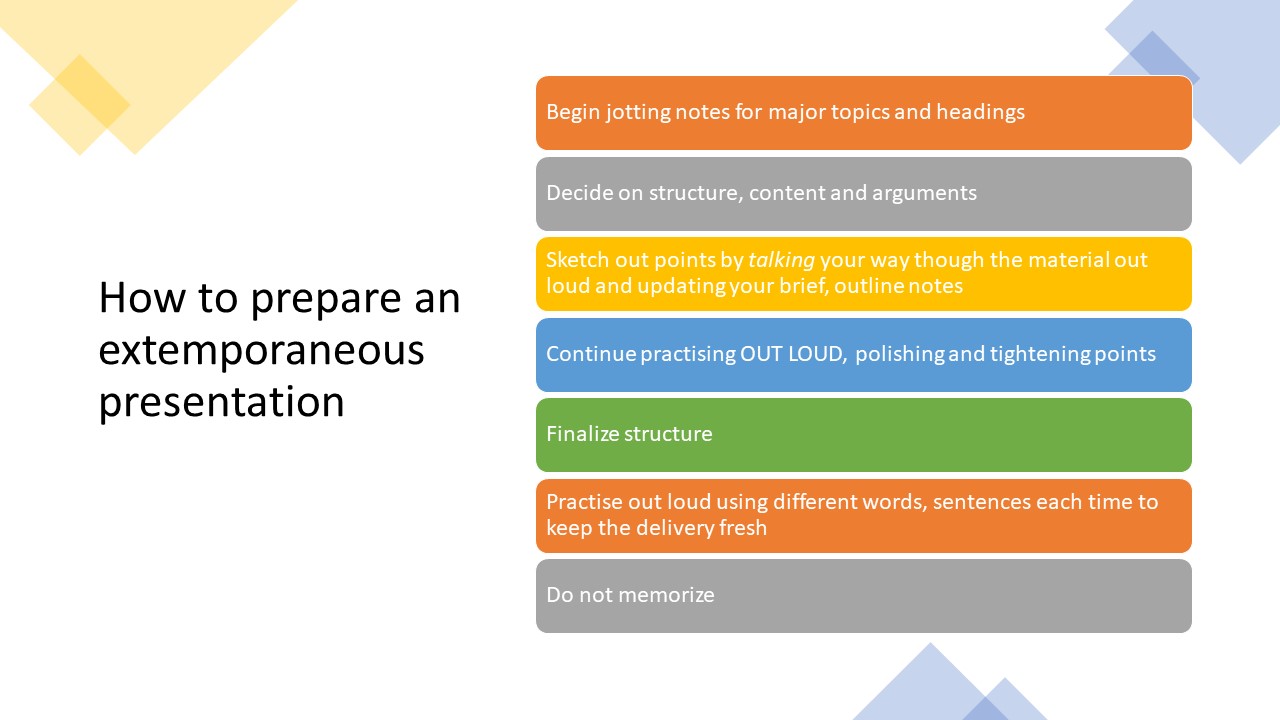If You Rely Upon a Script When Public Speaking It is Easy to
Chapter 32: Methods of Speech Delivery
By the end of this chapter, you should be able to:
- Distinguish between four methods of speech delivery: the impromptu speech, the manuscript speech, the memorized speech, and the extemporaneous speech
- List the advantages and disadvantages of the four types of speeches
- Explain why an extemporaneous is the preferred delivery style when using rhetorical theory
- impromptu
- manuscript
- memorized
- extemporaneous
We have established that presentations involve much more than the transfer of information. Sure, you could treat a presentation as an opportunity to simply read a report you've written out loud to a group, but you would fail to both engage your audience and make a connection with them. In other words, you would leave them wondering exactly why they had to listen to your presentation instead of reading it at their leisure.
One of the ways to ensure that you engage your audience effectively is by carefully considering how best to deliver your speech. Each of you has sat in a class, presentation, or meeting where you didn't feel interested in the information the presenter was sharing. Part of the reason for your disengagement likely originated in the presenter's method of speech delivery.
For our purposes, there are four different methods—or types—of speech delivery used in technical communication:
What comes to mind when you think about the four methods of speech delivery? How do you think they are different from one another? Have you given a speech using any of these methods before?
Watch the video below for a brief overview of each one. After you are finished, answer the questions below:
- Which method are you most comfortable with? Why?
- Which method are you the least comfortable with? Why?
- Which method do you think is the best for connecting with your audience? Why?
The public speaking section of this course will require you to deliver a speech using an style, but let's take a look at how all four differ in approach:
Impromptu Speeches

speaking is the presentation of a short message without advanced preparation. You have probably done impromptu speaking many times in informal, conversational settings. Self-introductions in group settings are examples of impromptu speaking: "Hi, my name is Shawnda, and I'm a student at the University of Saskatchewan."
Another example of impromptu speaking occurs when you answer a question such as, "What did you think of the movie?" Your response has not been pre-planned, and you are constructing your arguments and points as you speak. Even worse, you might find yourself going into a meeting when your boss announces to you, "I want you to talk about the last stage of the project" with no warning.
The advantage of this kind of speaking is that it's spontaneous and responsive in an animated group context. Thedisadvantage is that the speaker is giv en little or no time to contemplate the central theme of their message. As a result, the message may be disorganized and difficult for listeners to follow.
Here is a step-by-step guide that may be useful if you are called upon to give an impromptu speech in public:
- Take a moment to collect your thoughts and plan the main point that you want to make (like a mini thesis statement).
- Thank the person for inviting you to speak. Do not make comments about being unprepared, called upon at the last moment, on the spot, or uneasy. In other words, try to avoid being self-deprecating!
- Deliver your message, making your main point as briefly as you can while still covering it adequately and at a pace your listeners can follow.
- If you can use a structure, use numbers if possible: "Two main reasons. . ." or "Three parts of our plan. . ." or "Two side effects of this drug. . ." Past, present, and future or East Coast, Midwest, and West Coast are pre-fab structures.
- Thank the person again for the opportunity to speak.
- Stop talking. It is easy to "ramble on" when you don't have something prepared. If in front of an audience, don't keep talking as you move back to your seat.
Impromptu speeches are generally most successful when they are brief and focus on a single point.
We recommend practicing your impromptu speaking regularly. Do you want to work on reducing your vocalized pauses in a formal setting? Great! You can begin that process by being conscious of your vocalized fillers during informal conversations and settings.
Below are two examples of an speech. In the first video, a teacher is demonstrating an impromptu speech to his students on the topic of strawberries. He quickly jots down some notes before presenting.
What works in his speech? What could be improved?
Link to Original Video: tinyurl.com/impromptuteacher
In the above example, the teacher did an okay job, considering how little time he had to prepare.
In this next example, you will see just how badly an impromptu speech can go. It is a video of a best man speech at a wedding. Keep in mind that the speaker is the groom's brother.
Is there anything that he does well? What are some problems with his speech?
Link to Original Video: tinyurl.com/badimpromptubestman
Manuscript Speeches

speaking is the word-for-word iteration of a written message. In a manuscript speech, the speaker maintains their attention on the printed page except when using presentation aids.
The advantage to reading from a manuscript is the exact repetition of original words. This can be extremely important in some circumstances. For example, reading a statement about your organization's legal responsibilities to customers may require that the original words be exact. In reading one word at a time, in order, the only errors would typically be the mispronunciation of a word or stumbling over complex sentence structure. A manuscript speech may also be appropriate at a more formal affair (like a funeral), when your speech must be said exactly as written in order to convey the proper emotion the situation deserves.
However, there are costs involved in manuscript speaking. First, it's typically an uninteresting way to present. Unless the speaker has rehearsed the reading as a complete performance animated with vocal expression and gestures (well-known authors often do this for book readings), the presentation tends to be dull. Keeping one's eyes glued to the script prevents eye contact with the audience.
For this kind of "straight" manuscript speech to hold audience attention, the audience must be already interested in the message and speaker before the delivery begins. Finally, because the full notes are required, speakers often require a lectern to place their notes, restricting movement and the ability to engage with the audience. Without something to place the notes on, speakers have to manage full-page speaking notes, and that can be distracting.
It is worth noting that professional speakers, actors, news reporters, and politicians often read from an autocue device such as a teleprompter. This device is especially common when these people appear on television where eye contact with the camera is crucial. With practice, a speaker can achieve a conversational tone and give the impression of speaking extemporaneously and maintaining eye contact while using an autocue device.
However, success in this medium depends on two factors:
- the speaker is already an accomplished public speaker who has learned to use a conversational tone while delivering a prepared script, and
- the speech is written in a style that sounds conversational.
Below is a video that shows an example of a manuscript speech. In the video, US Presidential Historian, Doris Kearns Goodwin, gives a speech about different US presidents.
What works in her speech? What could be improved?
Link to Original Video: tinyurl.com/goodwindepauw
Memorized Speeches

speaking is reciting a written message that the speaker has committed to memory. Actors, of course, recite from memory whenever they perform from a script in a stage play, television program, or movie. When it comes to speeches, memorization can be useful when the message needs to be exact and the speaker doesn't want to be confined by notes.
The advantage to memorization is that it enables the speaker to maintain eye contact with the audience throughout the speech. Being free of notes means that you can move freely around the stage and use your hands to make gestures. If your speech uses presentation aids, this freedom is even more of an advantage.
Memorization, however, can be tricky. First, if you lose your place and start trying to ad lib, the contrast in your style of delivery will alert your audience that something is wrong. If you go completely blank during the presentation, it will be extremely difficult to find your place and keep going. Obviously, memorizing a typical seven-minute classroom speech takes a great deal of time and effort, and if you aren't used to memorizing, it is very difficult to pull off.
Below is a video that shows an example of a memorized speech. In the video, former Louisiana governor, Bobby Jindal, responds to Barack Obama's State of the Union address back in 2009.
What works in his speech? What could be improved?

speaking is the presentation of a carefully planned and rehearsed speech, spoken in a conversational manner using brief notes.
Speaking extemporaneously has some advantages. It promotes the likelihood that you, the speaker, will be perceived as knowledgeable and credible since you know the speech well enough that you don't need to read it. In addition, your audience is likely to pay better attention to the message because it is engaging both verbally and nonverbally.
By using notes rather than a full manuscript (or everything that you're going to say), the extemporaneous speaker can establish and maintain eye contact with the audience and assess how well they are understanding the speech as it progresses. It also allows flexibility; you are working from the strong foundation of an outline, but if you need to delete, add, or rephrase something at the last minute or to adapt to your audience, you can do so. The outline also helps you be aware of main ideas vs. subordinate ones.

Compared to the other three types of speech delivery, an extemporaneous style is the best for engaging your audience and making yourself sound like a natural speaker.
The video below provides some tips on how to deliver a speech using this method:
Link to Original Video: tinyurl.com/deliverextempres
The slide below provides a brief overview of tips for preparing your extemporaneous presentation:

Below is a video that shows an example of an speech. In the video, a former University of Saskatchewan student tries to persuade her peers to spend more solo time outside.
What works in her speech? What could be improved?
Link to Original Video: tinyurl.com/rcm401speech
- When designing any speech, it's important to consider how you will deliver that speech. In technical communication, there are four different types of speech delivery, each with their advantages and disadvantages. They are: , , , and .
- An impromptuspeech can take many forms such as a toast at a wedding, being asked to give a project update at a meeting, or even simply meeting someone for the first time. While this type of speech can be spontaneous and responsive, the speaker generally has little to no warning that they will need to speak.
- Amanuscript speech is completely written out and read word for word. It is often a good style when you want to nail the specific wording and do not want to make an error. However, this type of speech is not very persuasive because it does not take advantage of the immediacy of public speaking. It also completely removes audience relation from the process.
- Amemorizedspeech is when a speaker commits an entire speech to memory. This style also harms relation with the audience because the speaker is more focused on remembering the text of the speech rather than communicating with the audience. Additionally, if you lose your place and need to ad lib, it may be obvious to your audience.
- An extemporaneous speech is done in a natural, conversational speaking style. While it is carefully planned, it is never completely written out like a manuscript.It is also not read or memorized. Instead, an outline is used to help guide the speaker. As a result, more attention can be paid to the audience, allowing the speaker to better connect with them and make adjustments as necessary. This is the style we want you to use for your presentation assignment in RCM 200.
Attributions
This chapter is adapted from "Communication for Business Professionals" by eCampusOntario (on Open Library). It is licensed under Creative Commons Attribution-ShareAlike 4.0 International License.
This chapter is also adapted from "Speak Out, Call In: Public Speaking as Advocacy" by Meggie Mapes (on Pressbooks). It is licensed under a Creative Commons Attribution-NonCommercial-ShareAlike 4.0 International License.
williamsriefterin.blogspot.com
Source: https://openpress.usask.ca/rcm200/chapter/types-of-speeches/
0 Response to "If You Rely Upon a Script When Public Speaking It is Easy to"
Post a Comment